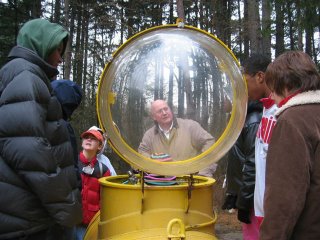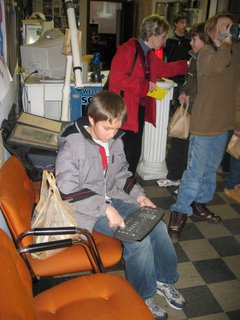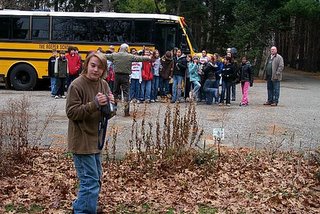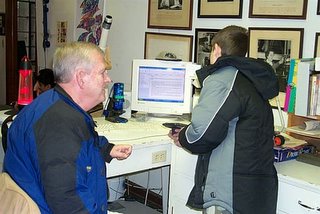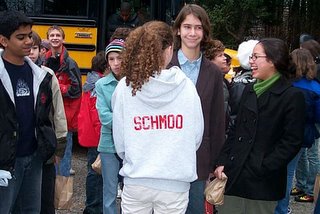Taking a Journey with Today's Digital Kids:An Interview with Deneen Frazier Bowenby
James L. Morrison and
Deneen Frazier BowenAt the 2005 National Educational Computing Conference (
NECC) in Philadelphia, Deneen Frazier Bowen gave a keynote presentation entitled "The Natives Are Restless" in which she used her acting skills to portray a cast of characters who revealed students’ struggles to connect school with "real life." Co-author of The Internet for Your Kids (1997) and a former educational software design consultant and K-12 academic technology coordinator, her unusual
presentation demonstrated considerable insight about how to engage the digital mindset and creative energy of young people. I interviewed her after the presentation.
James L. Morrison [JM]: Deneen, I sensed from your presentation that there is a growing disconnect between the lives of students in school and their lives outside of school. How are today's "digital natives" faring in schools?
Deneen Frazier Bowen [DB]: We need to ask our students that question directly. We can learn so much by just asking our students what works and does not work for them as learners in their schools.
My presentation is based on the recent research I have reviewed and direct conversations I have had with students and teachers over the past year. I do see a growing discontent among this current generation of students—or as Marc Prensky coined, the "digital natives"—that is palpable in a way we have never seen in education. Technology has become so ubiquitous in our society that students expect to be able to use it on demand to meet the needs in their lives.
Prensky provides a great overview, suggesting that how students interact with people and information is dramatically different than how the adults they encounter in their schools do. Indeed, many students' approach to learning involves behaviors that traditional school cultures view negatively. For example, they want to collaborate in ways that most classroom teachers perceive as cheating. In addition, students are discovering multiple sources for learning beyond their local school district, including, but not limited to, virtual schools, online courses, and private learning centers (Prensky
2004).
I first became aware of this expanding gap when I worked with the BellSouth Foundation on their edu.pwr3 grant program (Bell South
n.d.). Our report showed that although teachers increased their technology skills and technology integration in the curriculum, students saw no changes. For students, using more technology made no difference; the difference they sought was at the design and access levels. Teachers still designed the learning task and only provided access to those technologies with which they were comfortable. Students seek a change in process, not just the automation of a traditional one. I created this presentation because I believe we need to address this perception gap by developing systemic mechanisms for asking students questions, listening with students, and acting with students to bring teachers and students closer together as partners in the learning process.
JM: In your presentation you used a character-teacher who struggled to provide a multimedia presentation to an assembly of educators. She not only had difficulty using the technology, but she lost control of it when student-characters hacked into her computer using a bluetooth cell phone. What was your point in presenting this situation?
DB: Yes, I begin the presentation with the character of Dr. Priscilla Normal, a character with whom educators in the audience can connect and immediately relate. Almost every teacher, regardless of how technology savvy he/she is, has had the experience of technology not working as anticipated while in front of students. Dr. Normal’s experience is instantly recognizable and offers the audience a chance to laugh at that fear within themselves. Although Dr. Normal is far from technology savvy (she is scared she will push the wrong button in PowerPoint!), she tries her best to model the use of new technologies.
The character of Dr. Normal also offers the audience an opportunity to watch what may be an educator’s biggest fear—losing control of the technology and having 25 or more students take control and, perhaps, take over. In the presentation, the audience witnesses this happens to Dr. Normal. My point here is to demonstrate that this loss of control can happen, but that the result of that loss can have very positive results. Although teachers may find it uncomfortable sharing control with the students, they can learn what students really think if they provide students with the opportunity to use the digital tools to tell their stories.
The key to Dr. Normal is her reappearance at the end of the presentation after she bears witness to the three student characters—Edy, Maria, and Joanne—telling their stories. When she reappears, she does express feelings of anger, frustration, and discomfort, but she also shares the new questions that have emerged for her. She thought she was a leader in the field because she looked at the current demographic data about this new generation. After her presentation is "hijacked," she starts listening to students in a new way, contextualizing the data.
Significantly, the audience sees her return as a model of how to be a reflective practitioner. At the end, we see someone unsure of how to move forward but willing and open to learn. If teachers in the classroom do not possess that openness, the chances of students wanting to learn are slim to none. Instead of teachers, let’s call them lead learners. Every great teacher I have ever had has always talked about how much they learn from their students.
JM: Your presentation made use of various media to establish a technoscape consisting of handheld devices and the Internet where students are more proficient than those who educate them inside our schools. Particularly, you made use of
Keynote slides as well as audio and video clips, and the characters in the drama referenced a plethora of other types of digital media and devices. Why do you believe flexibility and diversity of technology to be an essential component to an effective teaching strategy?
DB: The world that we live in outside of school is absolutely full of all kinds of digital media and devices. We do not know how those devices will come together. We do not know 20 years out, 40 years out, 100 years out, how those technologies will influence the way we think. As a result, we are challenged as educators to engage students in using their imaginations about how to make the world a better place by creatively applying and developing this plethora of digital media and devices. How can we help students invent new ways of thinking by manipulating digital information? The students we work with will emerge out of the educational system into a society that has already been thinking about how to leverage new and converging technologies—personal digital assistant (PDA) cell phones that deliver on-demand video, for example. If educators ignore this societal force and put their heads in the sand, we will do a huge disservice to the students who will deal with that reality when they come out of school. The more we can empower them with the thinking processes and the ways of using their imagination, the better prepared they will be to play a role in creating the future.
In his new book The World Is Flat, Thomas Friedman (2005) posits that it is human innovation and imagination that ultimately limit the possibilities of technology, not the tools themselves. What he doesn’t discuss is how teachers are the key to engaging students in this higher level of critical thinking and problem solving. Teachers must create a safe and supported learning environment that guides their students’ imaginations toward creating, expanding, and refining the nascent innovative ideas they have about new ways of applying digital technologies to the challenges they see around themselves.
JM: The teacher-character exposed current attitudes of technology-beleaguered teachers and their fears about involving students in the learning design process. The student characters exposed frustration around the way their time is spent in classrooms. What do you see as the root of this tension?
DB: Tension between the generations is certainly not a new topic. The adults in the schools create and define the educational environment, and the students have to adapt and play by that generation’s set of rules. What is new is the acceleration of the gap between the generational thinking—the mindset of generations. The gap between how those mindsets operate has widened more than ever before because of technology. Historically, teachers have not engaged students in helping design the learning experience; teachers have not seen students as partners. However, this is not their fault. The educational system is designed around a hierarchical and authoritative premise, and technology challenges the system, not the teachers. Technology now gives us the opportunity to explore how to do that in a way that may not be as "scary."
The on-demand mindset that this generation has as a result of today’s digital technology deepens and enhances students’ frustration. They are used to getting the information they want when they need it. Memorization does not make sense to them. They value the skill of finding information over knowing information.
Today’s students equate "on-demand" with choice. They expect to be given multiple options from which they can choose. Think about how many choices they can make just for food in our society. This mindset crosses over into the classroom and becomes a source of tension when they are not given choices, when it is not an on-demand situation. Then they hit a wall. The students are not sure what to do with that so they get angry.
A lot of research shows that right now students seek alternative sources of learning. We have a booming market in virtual schools and online courses. Competition is a new landscape for school districts. While charter schools and voucher systems promised a competitive force that would ultimately help improve school systems, it is the virtual educational space that I think will have the biggest competitive impact. Now students can directly find and enroll in learning situations, discover new sources, new areas of learning, and actually go and do it on their terms.
JM: In the portrayal of the student-characters, it was evident that students are using technology outside of the school to connect to projects, ideas, and people. What do students perceive that they are learning?
DB: In the presentation, I portray the character of Joanna, an 11th-grader, who gets involved in a project through a Web site called
Taking it Global. This is an actual website where young people all over the world collaborate on projects to help their own and extended communities, completely independent of any traditional learning structures of environments. The idea for this character’s experience came from the research that I explored from
NetDay and its
Student Speak Up Day, a qualitative and quantitative data collection of hundreds of thousands of students. I spent a lot of time sifting through the qualitative data to find those touchstone comments that embody the current thinking of this generation of students. One student, somewhere between 6th grade and 12th, made a comment which stuck with me: "I get my assignments at school; I learn at home." This student uses technology to expand her knowledge base in a free and digital environment at home in order to complete the assignment for school. That comment really shows you that students feel limited and barred from their paths of learning in the traditional school. They believe they learn by working in a freer space.
JM: One of your student-characters criticized her school for refusing to be receptive to both the new ideas about ways of learning and for not engaging students who want to open a dialogue with their teachers about those ideas. How systemic is this perception of administrators and educators among students?
DB: The student character of Edy, an 8th-grader, is definitely the angriest of the three student characters in this presentation. She really embodies those students who have already or are in the process of checking out mentally because they do not feel "seen" in their schools. However, this character did feel "seen" on the Internet. She keeps a blog of her ideas and her concerns, and yet that information, though publicly available on the Internet, was not accepted in the school framework.
You are asking, "Is Edy’s experience, as I portray it, systemic?" I argue that it is. The educational systems typically do not offer students like Edy a place to contribute their ideas and concerns. No space exists for that information nor, more importantly, for the possible activities that might result from those contributions. Not every student feels locked out of the system to the extent Edy does. Those students involved in student technology groups or even student council often get access and even respect. But we now need to connect with all students about their digital mindsets, not just the "techy" kids. We need to think about how we can create spaces within the institutional structure where student ideas, concerns, and dreams can become part of the conversation at a stage when it can actually influence decision-making.
JM: Edy emphasized the usefulness of blogs to allow students to voice their frustrations and opinions about the ways they are being educated. In that scenario, the issue of free speech was raised when the principal requested the blog or post be removed. When services are provided for use off-campus, institutional control can be seriously compromised in the name of protecting our rights as citizens. Is this issue a growing concern for school administrators and one that may contribute to a lack of enthusiasm to erect Internet-based services?DB: We will be seeing a lot more of these situations in the future in terms of students using technologies in new ways to make their voices heard that will get complicated for educational systems. Ratings are a good example that is incredibly popular on the Internet. People rate postings to discussion boards, sellers and buyers on online auction sites, and even future commercials that will be aired on television. These ratings are everywhere, and we have begun to see a few communities where students and even parents use that technology to put pressure on schools. Individuals can quickly publish their ratings, reviews, and stories about their experiences in school. This changes the landscape for educational systems, but our systems are not equipped to handle that change. It perceives the information as a threat rather than vital for improvement. Often, leaders’ first instinct, and we see this widespread throughout the country, is to ban those technologies that they do not understand or cannot control. I do not have an answer for this question, but it is a growing issue. What we do know is that the outside information will impact and shape what happens inside our schools; we just do not yet know how.
JM: What can teachers do to be more receptive to those ideas when economic factors necessarily limit the feasibility of incorporating technologies into classroom practice (not to mention teacher-training)?
DB: I would like point your readers toward a new report "Listening to Student Voices" (Education Evolving
2005). This report shows that by engaging students in conversations and creative problem-solving about what happens in their schools, schools can uncover student ideas that can actually be cost-cutting. Students are an asset in our schools that, at best, we leverage only at a minimal level.
Their ideas can be cost-cutting in ways that we, the digital immigrants, do not see. Students can be imaginative in ways that we cannot because of their digital mindsets, because this is the world they live in all the time. Not every idea they have will be cost-cutting, but they do want us to do the best we can with the money we have. YouthPulse, a 2005 survey conducted by Harris Interactive, found that "Young people, 8 to 21, are a major U.S. consumer group across virtually all industries. They have great purchasing power, to the tune of $139 billion annually, and the influence they exert on their families' purchase decisions is enormous" (Harris Interactive
2005, ¶ 1).
They are eager to help influence, in a positive way, decisions in their schools as well. They know the value in ways that often adults do not. I think that if we bring students into the process, we will find ways to save money and, rather than expand our purchases on hardware, actually use what we have to the utmost.
In addition, many school districts use students in the training experience, often to teach teachers. This models that partnership I mentioned earlier. We can actually engage students in the training experience and possibly reduce the actual dollars we spend on those experiences by levering an asset we already have in our schools. At the same time, the students will learn communication, leadership, and training skills that will be very valuable to them when they go out into the world.
JM: In your drama, I thought that the story of the student computer club acting as a liaison for other students and the school board was illuminative of how educators involve students in meeting the challenge of using information technology tools to enhance the educational processes in their schools. Please tell our audience about this and other strategies to employ students in this fashion.
DB: In the presentation, Maria, a 5th-grader, has been invited to participate in something called the district technology advisory board. This idea from an actual school district in Tennessee,
Williamson County Schools, that not only has a district technology advisory board made up of students from a variety of grade levels and a variety of schools but is engaged at a level that I have not seen in any other district. In many schools, student technology teams are often charged with creating and maintaining the school website or doing technical support or training like the SWAT teams. In Williamson County, student involvement goes far beyond this as students are asked to contribute their perspectives and ideas at a very early stage in the decision-making process. These students not only help the district develop possible solutions but also help define the problem in the first place. An example of this is when the student advisory board contributed language that the district now uses to define a "technology savvy principal." The students contributed to the set of capabilities that they seek from school leaders in that district. Not only did the students see that their ideas were valued, but they also obviously contributed something unique that none of the adults in the district had thought to include. They had a direct impact on how that district defines leadership behavior. That is powerful, and that is the kind of engagement I personally encourage in schools.
JM: Deneen, NECC has thoughtfully provided the Internet community with a
webcast of the performance. I hope that this interview induces our audience to view the session. It was powerful and timely.
References
BellSouth Foundation. n.d. edu.pwr3.
http://www.bellsouth.com/education/index_edupower.html (accessed November 15, 2005).
Education Evolving. 2005. Listening to student voices.
http://www.educationevolving.org/pdf/Listening_to_Student_Voices.pdf (accessed November 15, 2005).Frazier, D., B. Kurshan, S. Armstrong, and J. Blackburn. 1997. The Internet for your kids. Almeda, CA: Sybex Inc.
Friedman, T. L. 2005. The world is flat. New York: Farrar, Straus and Giroux.
Harris Interactive. 2005. YouthPulseSM 2005.
http://www.harrisinteractive.com/expertise/youthpulse.asp (accessed November 15, 2005).
Prensky, M. 2004. The emerging online life of the digital native.
http://www.marcprensky.com/writing/PrenskyThe_Emerging_Online_Life_of_the_Digital_Native-03.pdf (accessed November 15, 2005).
Copyright and Citation Information for this ArticleThis article may be reproduced and distributed for educational purposes if the following attribution is included in the document:
Note: This article was originally published in Innovate (http://www.innovateonline.info/) as: Morrison, J., and D. Frazier Bowen. 2005. Taking a journey with today's digital kids: An interview with Deneen Frazier Bowen. Innovate 2 (2). http://www.innovateonline.info/index.php?view=article&id=230 (accessed December 8, 2005).
The article is reprinted here with permission of the publisher, The Fischler School of Education and Human Services at Nova Southeastern University.
Innovate is a publication of
Nova Southeastern University.








